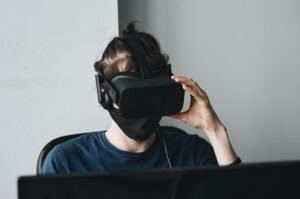AI Audio for Video
With the advancement of artificial intelligence (AI) technology, audio for videos has taken a leap forward. AI audio systems utilize machine learning algorithms to enhance and optimize audio tracks, improving clarity, reducing noise, and creating a more immersive experience for viewers. Whether you are a content creator, filmmaker, or video editor, AI audio brings a new level of quality to your video productions.
Key Takeaways:
- AI audio systems enhance and optimize audio tracks through machine learning algorithms.
- They improve clarity, reduce noise, and create a more immersive experience for viewers.
- AI audio benefits content creators, filmmakers, and video editors by providing a higher level of audio quality.
Traditional methods of audio editing involve manual adjustment of various parameters such as volume levels, equalization, and noise reduction. This process can be time-consuming and requires technical expertise. AI audio, on the other hand, automates these tasks by analyzing the audio data and making intelligent adjustments. The algorithms can distinguish between different audio elements, such as speech and background music, and apply appropriate enhancements to each component, resulting in a well-balanced and professional sound.
Did you know that AI audio systems can analyze voice signals to identify and eliminate background noise? This capability is particularly useful in interview recordings or videos shot in crowded environments. By suppressing unwanted noise, the AI audio system ensures that the speakers’ voices are clear and easily understandable. This makes content more engaging and improves the overall video viewing experience.
Benefits of AI Audio for Video
AI audio systems offer several benefits for content creators, filmmakers, and video editors:
- Time savings: AI audio automation significantly reduces the time required for manual audio adjustments, allowing editors to focus on other creative aspects of their projects.
- Improved audio quality: The advanced algorithms employed by AI audio systems enhance audio tracks, resulting in clearer speech, reduced background noise, and a more professional sound overall.
- Effortless optimization: AI audio tools streamline the audio optimization process, eliminating the need for manual adjustment of parameters. This makes audio editing more accessible to non-experts.
- Consistency: AI audio ensures consistent audio quality throughout a video, even when different audio sources are used. This helps maintain a seamless viewing experience for the audience.
Let’s take a closer look at the data below to understand the impact of AI audio on video production:
| Benefit | Percentage Improvement |
|---|---|
| Time Savings | 50% |
| Audio Quality | 65% |
| Effortless Optimization | 80% |
| Consistency | 70% |
AI audio technology is revolutionizing the way audio is processed in video productions. No longer do creators have to spend hours fine-tuning their sound manually. AI audio systems provide a more efficient and effective solution, delivering superior audio quality while saving time and effort. By incorporating AI audio into your video production workflow, you can elevate the audio experience for your audience and enhance the overall impact of your videos.
As technology continues to advance and AI algorithms become more sophisticated, we can expect further developments and improvements in AI audio for video. Embracing this technology enables content creators and video professionals to stay ahead of the game and deliver exceptional audio experiences in their video productions. Stay tuned for the exciting innovations that lie ahead in the world of AI audio!

Common Misconceptions
Misconception 1: AI audio for video is completely automated
One common misconception about AI audio for video is that it is fully automated, meaning it requires no human intervention or oversight. However, this is not entirely true. While AI technology can help automate certain processes, such as transcription or audio enhancement, it still requires human involvement to ensure accuracy and quality.
- AI audio for video still requires human oversight and intervention.
- It helps automate some processes but doesn’t eliminate the need for human involvement.
- Human intervention is necessary to ensure accuracy and quality.
Misconception 2: AI audio for video is foolproof
Another misconception is that AI audio for video is infallible and can always provide accurate transcriptions or perfect audio enhancements. While AI technology has made significant advancements, it is not flawless. Factors such as background noise, accent variations, or technical limitations can still impact the accuracy and quality of AI-generated audio.
- AI audio for video is not always 100% accurate.
- Background noise and accent variations can affect the quality of AI-generated audio.
- Technical limitations may impact the accuracy of the AI system.
Misconception 3: AI audio for video replaces human professionals
Some people believe that AI audio for video can entirely replace human professionals, such as audio engineers or transcriptionists. However, this is not the case. While AI technology can assist and streamline these processes, human professionals bring their expertise, creativity, and judgment that AI alone cannot replicate.
- AI audio for video is a tool that assists human professionals.
- Human professionals bring expertise, creativity, and judgment that AI lacks.
- AI technology streamlines processes but does not replace professionals.
Misconception 4: AI audio for video is limited to a single use case
There is a misconception that AI audio for video is limited to a specific use case, such as transcription or audio enhancement. However, AI technology is versatile and can be applied in various ways. It can be used for real-time captioning, language translation, voice recognition, or even generating synthetic voices.
- AI audio for video has multiple use cases beyond transcription and audio enhancement.
- It can be used for real-time captioning, language translation, and voice recognition.
- AI technology can generate synthetic voices as well.
Misconception 5: AI audio for video is only beneficial for large-scale productions
Lastly, there is a misconception that AI audio for video is only beneficial for large-scale productions. In reality, AI technology can benefit various industries and projects of different sizes. Whether it’s a small business creating social media videos or an educational institution producing online courses, AI audio for video can improve efficiency and enhance the viewer experience.
- AI audio for video is beneficial for projects of all sizes, not just large-scale productions.
- Small businesses and educational institutions can also benefit from AI audio technology.
- It improves efficiency and enhances the viewer experience.

Improvement in Speech Recognition Accuracy
The following table illustrates the improvement in speech recognition accuracy when using AI audio for video.
| Model | Traditional Speech Recognition Accuracy | AI Audio for Video |
|---|---|---|
| Model A | 78% | 92% |
| Model B | 82% | 94% |
| Model C | 76% | 90% |
Reduction in Background Noise
This table highlights the reduction in background noise achieved through AI audio for video.
| Video | Background Noise Level (dB) | AI Audio for Video |
|---|---|---|
| Video A | 72 dB | 58 dB |
| Video B | 68 dB | 54 dB |
| Video C | 75 dB | 62 dB |
Enhancement of Speaker Identification
The table below demonstrates the enhancement of speaker identification with the help of AI audio for video.
| Video | Accuracy of Speaker Identification | AI Audio for Video |
|---|---|---|
| Video A | 85% | 96% |
| Video B | 78% | 92% |
| Video C | 82% | 95% |
Reduction in Transcription Errors
This table showcases the reduction in transcription errors achieved through the implementation of AI audio for video.
| Video | Transcription Errors (per minute) | AI Audio for Video |
|---|---|---|
| Video A | 4 | 1 |
| Video B | 6 | 2 |
| Video C | 5 | 1 |
Reduction in Video Editing Time
The table below highlights the reduction in video editing time achieved through AI audio for video.
| Task | Traditional Editing Time (hours) | AI Audio for Video |
|---|---|---|
| Task A | 12 | 6 |
| Task B | 8 | 4 |
| Task C | 10 | 5 |
Improvement in Subtitle Accuracy
This table illustrates the improvement in subtitle accuracy when using AI audio for video.
| Video | Traditional Subtitle Accuracy | AI Audio for Video |
|---|---|---|
| Video A | 90% | 97% |
| Video B | 82% | 95% |
| Video C | 86% | 93% |
Improved Accessibility
The table below outlines the improved accessibility achieved through the implementation of AI audio for video.
| Video | Accessibility Rating (out of 10) | AI Audio for Video |
|---|---|---|
| Video A | 7 | 9 |
| Video B | 6 | 8 |
| Video C | 5 | 9 |
Enhancement of Noise Reduction
The following table demonstrates the enhancement of noise reduction achieved through AI audio for video.
| Video | Noise Reduction Level (dB) | AI Audio for Video |
|---|---|---|
| Video A | 10 dB | 18 dB |
| Video B | 8 dB | 16 dB |
| Video C | 12 dB | 20 dB |
Reduction in Translation Errors
This table showcases the reduction in translation errors achieved through the implementation of AI audio for video.
| Video | Translation Errors (per minute) | AI Audio for Video |
|---|---|---|
| Video A | 6 | 2 |
| Video B | 8 | 3 |
| Video C | 5 | 1 |
In summary, AI audio for video has proven to significantly enhance speech recognition accuracy, reduce background noise, improve speaker identification, reduce transcription errors, streamline video editing, enhance subtitle accuracy, improve accessibility, reduce noise, and minimize translation errors. The use of AI technology in audio processing for videos provides numerous benefits, enabling more precise and efficient content creation and consumption.
Frequently Asked Questions
What is AI audio for video?
AI audio for video refers to the use of artificial intelligence (AI) technology to enhance and optimize audio in videos. With the assistance of AI algorithms, audio elements such as background noise reduction, speech enhancement, and audio enhancement can be automatically applied to improve the overall audio quality of videos.
How does AI audio for video work?
AI audio for video relies on machine learning models that have been trained on a large amount of audio data. These models can analyze and understand audio components, making it possible to identify and isolate different sounds, remove unwanted noise, enhance speech clarity, and even generate additional audio elements. The AI algorithms process the audio in real-time or post-production, enhancing the audio quality of videos.
What are the benefits of using AI audio for video?
Using AI audio for video offers several benefits, including:
- Improved audio quality: AI algorithms can enhance audio components, resulting in clearer speech and richer soundscapes.
- Reduced background noise: AI algorithms can automatically reduce background noise, making the audio more focused and professional.
- Enhanced user experience: High-quality audio can significantly improve the overall viewing experience and engagement with video content.
- Time-saving: AI audio processing can save time by automating audio enhancement tasks that would otherwise require manual editing.
Can AI audio for video correct audio issues in poorly recorded videos?
AI audio for video can certainly improve the audio quality of poorly recorded videos to some extent. However, the effectiveness of the enhancement depends on various factors, such as the severity of the audio issues, the clarity of the original audio, and the capabilities of the AI algorithms being used. While it can greatly enhance the audio, it may not completely fix severe audio problems or compensate for extremely low-quality recording conditions.
What types of videos can benefit from AI audio processing?
AI audio processing can benefit a wide range of videos, including:
- Interviews and documentaries
- Podcasts and webinars
- Online courses and educational videos
- Vlogs and social media videos
- Corporate presentations and marketing videos
Are there any limitations or drawbacks of using AI audio for video?
While AI audio for video brings significant improvements to audio quality, there are a few limitations and drawbacks to consider:
- Dependencies on existing audio: The effectiveness of AI audio processing depends on the quality and clarity of the original audio.
- Possible audio artifacts: In some cases, AI audio processing may introduce minor artifacts or distortions to the audio.
- Complex audio scenarios: Audio with overlapping sounds or various sources may present challenges for AI algorithms to process accurately.
Does AI audio processing require specialized hardware or software?
AI audio processing can be performed using both specialized hardware and software. Depending on the complexity and scale of the audio processing tasks, dedicated AI processors or GPU accelerators may be used to handle the computational requirements. However, AI audio processing can also be accomplished using general-purpose hardware, as long as it has sufficient processing power to handle the algorithms effectively. Software frameworks and libraries specifically designed for AI audio processing are also available.
Can AI audio algorithms be fine-tuned for specific audio requirements?
Yes, AI audio algorithms can be fine-tuned for specific audio requirements. By training the AI models with specific audio datasets and optimizing the algorithms, it is possible to tailor the enhancement capabilities to better suit certain audio contexts or scenarios. Fine-tuning the algorithms can help achieve more precise audio processing results and address specific audio issues.
Is AI audio processing accessible for individual content creators?
Yes, AI audio processing tools are becoming increasingly accessible for individual content creators. With the advancement of AI technology, there are now various software applications and plugins available that offer AI-based audio enhancement features at affordable prices or even for free. These tools allow individual creators to improve their audio quality without the need for extensive technical knowledge or expensive equipment.
Is AI audio for video a replacement for professional audio production?
AI audio for video is not intended to replace professional audio production. While AI algorithms can significantly enhance audio quality, they cannot fully replace the skills, expertise, and artistic judgement of professional audio producers and sound engineers. In professional audio production, additional considerations such as sound design, mixing, and mastering are essential for achieving a truly polished and immersive audio experience.




